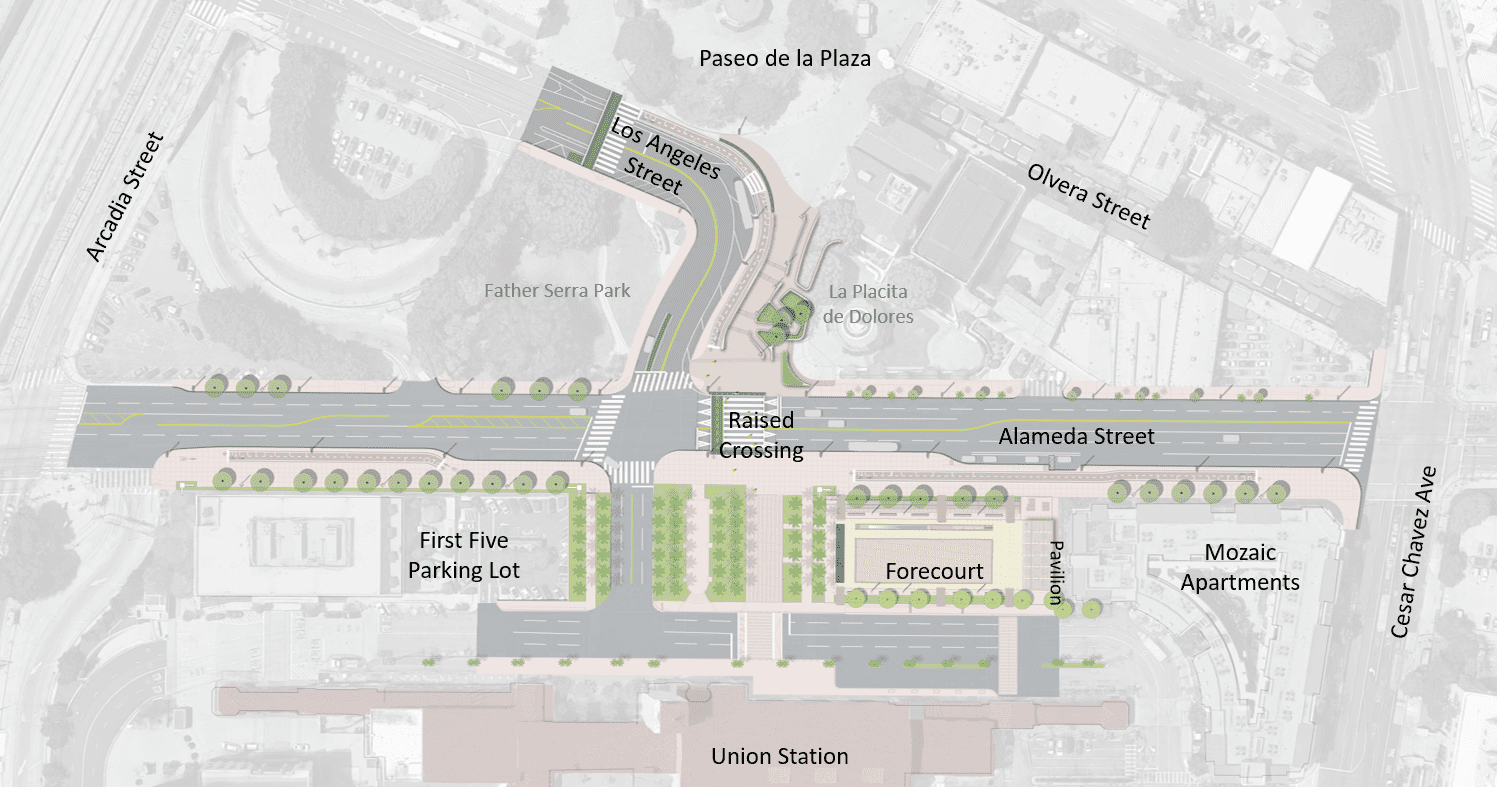For the past half-decade, Metro has been planning upgrades to Union Station to make the site easier and safer to access on foot and by bike. The L.A. Union Station Forecourt and Esplanade Improvements project includes upgrades on the Union Station grounds, which Metro owns, as well as upgrades to nearby streets, which are controlled by the city of Los Angeles.
The latest version of the project plan removes and waters down some core pedestrian aspects of the project. Why? Because, even in its most transit-accessible and most heavily walked core downtown areas, Los Angeles city departments are unwilling to prioritize the safety and convenience of people walking - instead they are insisting on car-centric standards that foster more driving.
In finalizing the design, last month Metro released a second addendum revising the project's 2018 Final Environmental Impact Report (FEIR) and a 2018 addendum. Metro is currently accepting public comment on the new FEIR addendum; the deadline for comments is Wednesday, August 26. Tonight Metro will host a virtual public meeting from 6-7:30 p.m.; meeting details are at the Metro project page and the bottom of this post.
After Metro purchased Union Station in 2011, the agency led a master planning project for the site and its connections to nearby neighborhoods. Metro approved the Connect US Action Plan in 2015. The Forecourt and Esplanade Improvements grew out of that plan. These improvements are focused on the front of Union Station and its connection with L.A.'s historic central plaza area: El Pueblo and Olvera Street.
For its more than 200-year-long history, the El Pueblo area has always been a place experienced only on foot. For the last half century, the city has worked to destroy its walkability. The 101 Freeway cut it off from the rest of downtown; car-choked freeway on and off-ramps make walking and biking in the area dangerous and unpleasant. And yet it remains a popular, heavily walked place. El Pueblo has long been a tourist destination and a place to learn about and experience L.A. history, especially early indigenous and Latinx history. New museums and programming are enhancing its status as a cultural destination. New housing developments immediately north, west, and south of El Pueblo are contributing to the area's already-strong pedestrian activity.
And yet the city continues to fail to embrace the character of the area.
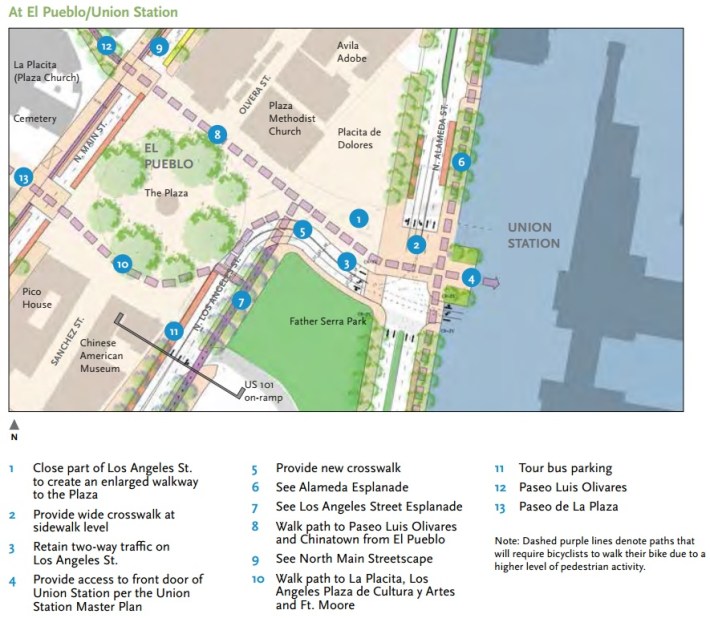
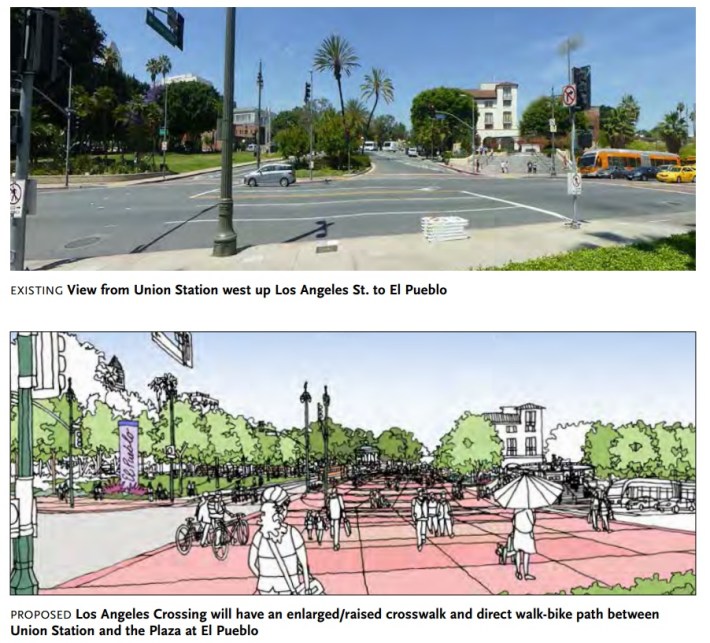
Metro's Connect US plan called the connection between Union Station and El Pueblo 'Los Angeles Crossing,' and put it at the core of the Forecourt and Esplanade Improvements project.
Project meetings and outreach got underway in 2017. Early ambitious plans were trimmed somewhat when Metro came up against utility relocation and the likelihood of uncovering archeological artifacts in this richly historic area.
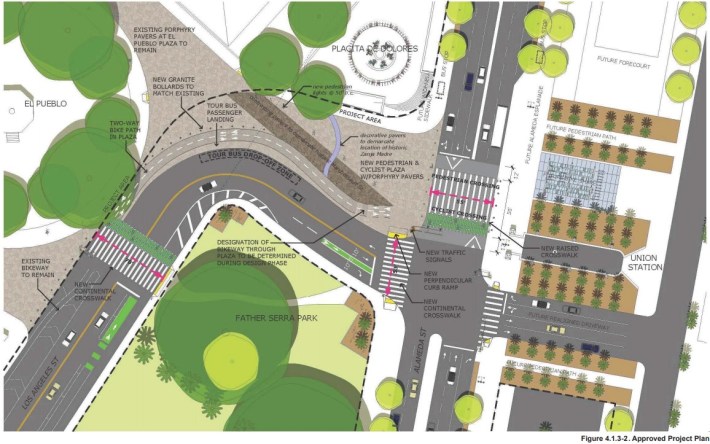
In 2018, Metro settled on a design that would significantly improve the quality of pedestrian access to Union Station. That design included sidewalk expansion, focused on widened sidewalks on both the east side of Alameda Street - on Metro property - and the north side of Los Angeles Street connecting to the plaza. On Alameda, the design called for a substantial shade canopy, with a double row of sidewalk trees. In order to give pedestrians and cyclists a dedicated crossing between Union Station and El Pueblo, the plan eliminated vehicle left turns from Los Angeles Street onto Alameda.
The 2018 version was approved by Metro. Design work got underway, which then hit some snags, leading to the new July 2020 design.
There are still worthwhile features in the latest design iteration. Metro plans to convert some Union Station parking to a pedestrian forecourt. On Alameda and Los Angeles Street, roadways are being narrowed to widen sidewalks. The project enhances the existing protected bike lanes on Los Angeles Street, and adds two short stretches of bikeway to Union Station's Alameda frontage.
Unfortunately, though, the 2020 design (shown at the top of this post, modifications shown in the image below) significantly scales back several key features that have been in the plan for the past half-decade.
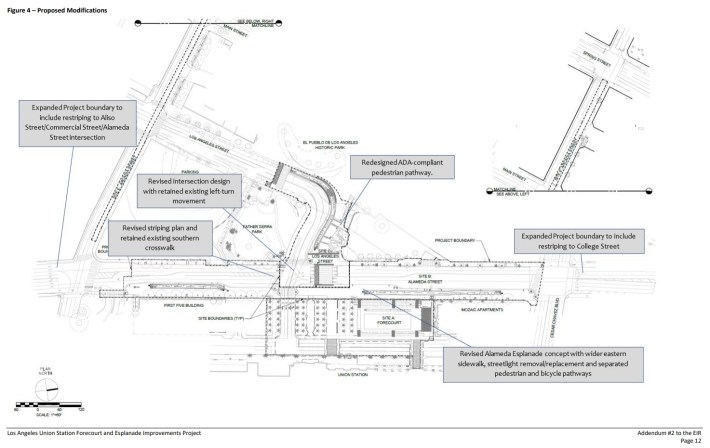
The project's design process has been a tug-of-war, with walk/bike advocates and Metro pushing for effective site-specific walkability features, and L.A. City departments insisting on car-centric business-as-usual standards.
In 2018, L.A. City Transportation Department (LADOT) required that Metro add a dedicated right-turn lane on the east side of Alameda to prioritize driver access to Union Station. But giving that space to right-turning drivers disconnected two segments of the two-way protected bikeway planned along Alameda. That is, both the 2018 and 2020 plans render the bikeways nearly useless, just so more drivers can turn right.
Now in the 2020 revised plan, LADOT and other city departments are further chipping away at other active transportation aspects of the project.
A few LADOT vetoes have undermined the hallmark fifty-foot-wide raised crosswalk across Alameda Street that Metro has been billing as the centerpiece of the project. The landmark raised crossing has been trimmed down to about 34 feet, and would no longer provide a direct line of access to the Union Station entrance. Instead, pedestrians would be forced to follow a zig-zag route.
The raised crossing itself had been planned to be eight inches high, flush with sidewalks. At that height, the raised crosswalk "speed table" would force drivers to reduce speeds on Alameda, provide better accessibility for people with disabilities, and clearly signal that this space is for pedestrians. LADOT required Metro to trim the height of the crosswalk to only three inches, which makes it much less effective and less accessible.
Most pernicious though, is LADOT's insistence on allowing drivers to turn left from Los Angeles Street onto Alameda Street.
With expanded sidewalk/bikeway space, the project would narrow northbound/eastbound Los Angeles Street to two lanes. Of these two lanes, the right one would be designated for right turns only. LADOT is insisting that the left lane be shared by drivers going straight towards Union Station or left onto Alameda. Also with this configuration, pedestrians using the raised crosswalk would no longer have a designated walk cycle free from turning drivers. Any driver who is turning left would have to wait for pedestrians, causing cars to back up in that lane. This will force the city to shorten pedestrian crossing times and lengthen driver green signals, undermining the priority given to pedestrians. It would also make the experience of crossing Alameda much more stressful than it needs to be.
Earlier this week, Streetsblog asked LADOT why they were insisting on the left turn and the lowered crosswalk height. As of press time, LADOT has not responded.
Also disappointing, the new design removes the planned double row of trees along the east side of Alameda, and realigns other shade trees away from the expanded sidewalk.
Metro attributes this downgrade to the city of L.A. Public Works Bureau of Street Service 'Streets L.A.' and the Bureau of Sanitation not permitting a double row of trees. Streets L.A. spokesperson Martin Schlageter told Streetsblog that the double row of trees would have required Metro to redo the storm drain and sewer that run under the east side of Alameda. Schlageter stated that "the city encouraged larger trees, which would have required the project to encase the sewer line in concrete." To stick to its budget, Metro decided to forgo the costly sewer upgrade, and instead opted to eliminate shade cover. What would have been a very walkable, shady place is now looking like the rest of L.A.'s all-too-typical sun-scorched, inhospitable sidewalks. L.A. to pedestrians: just get in the car.
What is perhaps most sad about the new design is that it ignores the significance of connecting Union Station and El Pueblo. If the city of L.A. won't prioritize walkability at the front door of the region's most heavily-used transit hub and at in its historic walkable core, is there anywhere where Angelenos can expect safe and convenient places to walk? Continuing to apply outdated late-20th-Century one-size-fits-all standards erodes what already works in these precious historic places.
Metro is currently taking input on its 2020 "final" design. Interested people and organizations should submit comments, but it may take some leadership to get the city and Metro to work together to steer the most worthwhile version of the project to completion. The project is located in the city's 14th Council District, currently vacant due to former Councilmember José Huizar's corruption scandal. Perhaps Mayor Eric Garcetti - in his leadership roles both over city departments and at Metro - or his appointed Public Works commissioners can help bring the project to fruition.
Details for tonight's 6-7:30 p.m. virtual L.A. Union Station Forecourt and Esplanade Improvements community meeting, which will provide a project update, an update on Addendum 2 to the Final Environmental Impact Report, and an overview of the upcoming utility survey on Alameda and Los Angeles Streets:
- Click for Microsoft Teams meeting link
- For audio only, listen to the meeting in Spanish at (877) 422-8614, conference ID 4770366# or in English at (877) 422-8614, conference ID 4770364#
Thanks to walk/bike advocate Michael MacDonald for providing a great deal of background information for this post, and for advocating for a more walkable, bikeable Union Station for many years.
